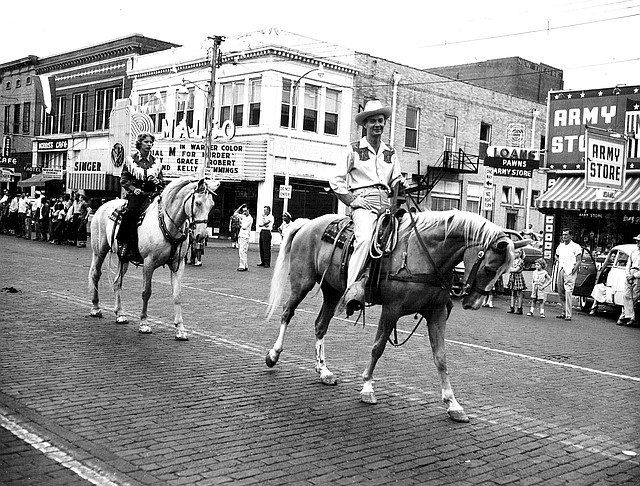Ropin', Ridin', Rememberin'
Fort Smith Museum lassos history of River Valley rodeo
COURTESY PHOTO Building its 80-year tradition, the Old Fort Days Rodeo rides the trail in the 1955 rodeo parade through historic downtown Fort Smith. This year’s rodeo has already wrapped up, but the “Ready to Rodeo” exhibit continues through the summer at the Fort Smith Museum of History.
Friday, June 13, 2014
As Springdale gears up for the 70th Rodeo of the Ozarks, the Fort Smith Museum of History pays tribute to the 80-year-old Old Fort Days Rodeo with an exhibit titled "Ready to Rodeo."
The "Ready to Rodeo" exhibit proved popular in 2002, so the museum revised it for Western Heritage Month in May and on through the summer, says the museum's executive director Leisha Gramlich, who added cowboy boots and a bandana to her professional dress recently.
FAQ
‘Ready to Rodeo’
WHEN — 10 a.m. to 5 p.m. Tuesday to Saturday, through the summer
WHERE — Fort Smith Museum of History, 320 Rogers Ave.
COST — $5 for adults, $2 for children 6-15, free for children younger than 6
INFO — 783-7841, fortsmithmuseum.com
"I remember as a little girl, the week of the rodeo we'd wear Western clothes," she says. Part of the rodeo excitement came from wearing Western clothes downtown in the days before the rodeo -- and if one didn't, the penalty equaled a buck-off, Gramlich notes, pointing to a black-and-white picture of a citizen thrown into a stock tank of water.
A wall of old rodeo photos -- on display for years in the rodeo office at Kay Rogers Park -- hangs on the wall across from the elevator in the upstairs gallery of the museum. "That (North 10th Street and Garrison Avenue) intersection was a popular place to take photos," Gramlich notes.
Many of the photos show prominent people -- including Kay Rogers and Bert Harper, for whom the rodeo grounds are now named -- waving from their horses as they crossed that site during annual rodeo parades. The movie theater in the background also served as a record of history, with the different movie names displayed each year on the marquee, Gramlich showed.
The first "official" rodeo in Fort Smith took place in 1933 at Andrews Field baseball park where the city's National Cemetery is today, Gramlich says. Some of the same promoters also produced the Pawnee Bill Show, which provided Western entertainment at the stockyards across the Arkansas River in Moffett, Okla., Gramlich says.
From 1934 to 1977, the Fort Smith event held the name Arkansas-Oklahoma, she adds.
The museum's rodeo exhibit features Bob Cole, a bull rider now in his 80s. He rode horseback as the grand marshal in last year's rodeo parade, Gramlich notes. "He opened the rodeo wearing his Air Force uniform and his medals," which he later donated to the museum, she says.
A world champion calf roper, Jerry Bob Hansen of Vian, Okla., donated his trophy belt buckles, and colorful green and yellow boots draw the eye to the display of items from Bobby Clark of Poteau, the youngest trick rider. He went to Hollywood when he was 13 years old, in about 1938, Gramlich says.
Every year, a movie star came to the rodeo, Gramlich recalls, showing display pictures of Ken Curtis, Festus of "Gunsmoke" fame; Michael Ansara, who played the Indian Cochise in the "Broken Arrow" series and, for a time was married to Barbara Eden of "I Dream of Jeannie," who accompanied him to Fort Smith.
And one picture shows the Old Fort Days' own hall-of-famer, Denny Flynn, in one of his famous bull rides. A 10-time National Finals Rodeo bull rider, who won the average for a record of three times, currently serves as the executive director of Old Fort Days. Flynn was admitted to the Pro Rodeo Cowboy Hall of Fame for lifetime achievement in 2001.
"Ready to Rodeo" is set among the museum's permanent collection, "In the Shadow of the Gallows," which reflects the identity of the town, from the Wild West in the late 1800s to the tourist destination since the highways arrived in the 1950s.
NAN What's Up on 06/13/2014